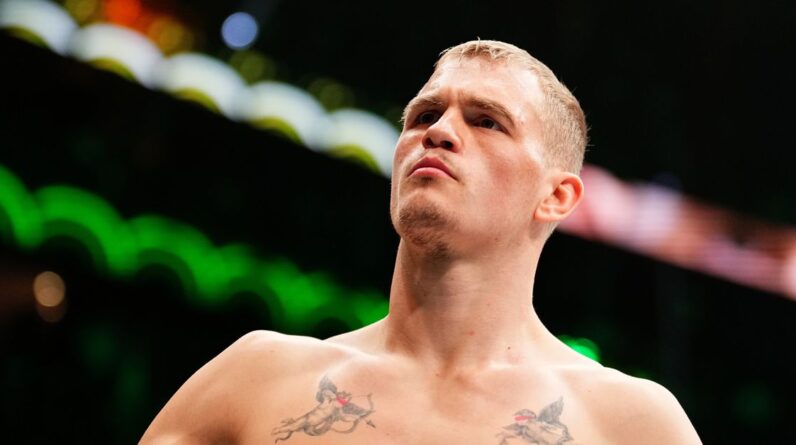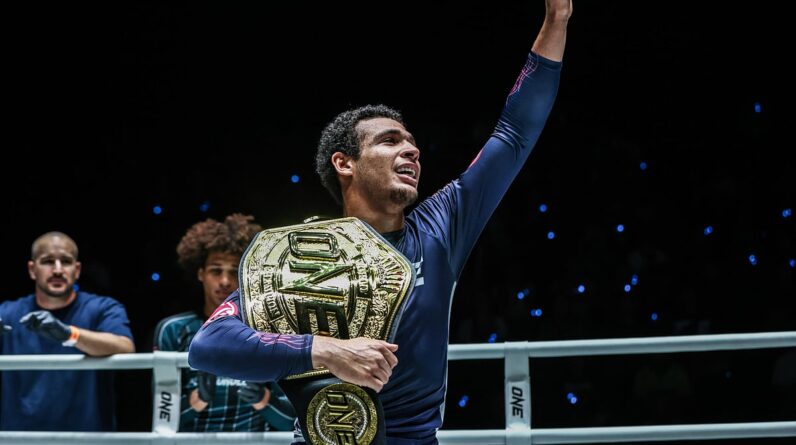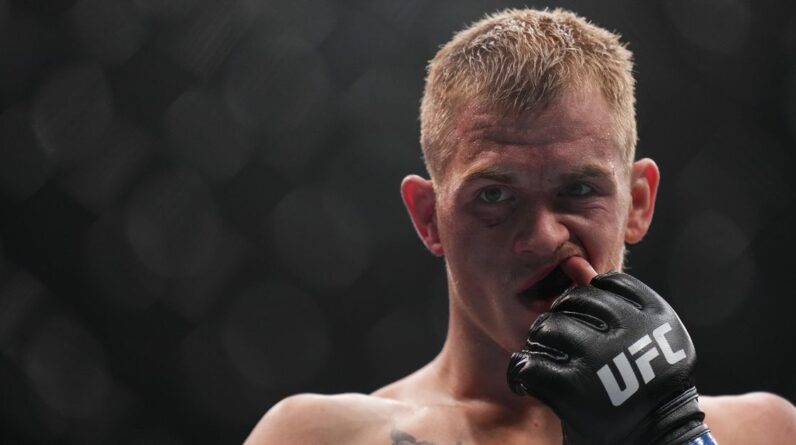Dmitry Bivol took on a dangerous challenger this weekend, with Gilberto ‘Zurdo’ Ramirez stepping up to challenge him for his title and his newly heightened status at the top of boxing. Zurdo was never going to be the technician Canelo is, but he’s a lot bigger (bigger than Bivol) and a good combination puncher, and that was going to offer its own difficulties for the champion. One option could have been to use his superior footwork to simply jab his way to victory- something he’s done before in earlier fights in his career. Instead, though, we saw another masterful display of perfectly timed pressure, keeping Zurdo constantly off-balance and unsure of how to respond. Let’s take a look.
The Breakdown
It starts from the feet. Of course, there’s more to it than that, and the fact that everything about Bivol’s game is so well connected is part of what makes him great. But, as so so often in boxing, the feet is where it all flows from. Zurdo’s footwork is by turns stompy and leaping, and always a bit straight-lined. Bivol’s is none of those things, and he used that class difference to keep Zurdo out of his comfort zone at all times.
To really explain what that means, it’s probably worth noting what Zurdo’s comfort zone is. It’s a pretty narrow space, which was a lot of the source of his downfall: in front of him, where he can throw his sharp, smart mid-distance combinations. Not too close, because then he starts to smother and wing his punches, and not too far, because he doesn’t really have the footwork to close range comfortably. Till now, he’s been able to herd opponents into that zone and punish them, but today was a new level of opponent. Bivol knew his weaknesses, and preyed on them relentlessly.
To start off, he opted to push into Zurdo’s personal space- not too aggressively, certainly not recklessly, but edging in just far enough that, in his efforts to keep that comfortable distance, the challenger would start backing up. In that way, Bivol took control of the initiative pretty much immediately, and Zurdo was the one needing to respond. Aware of the problem, he would make forays forward, but that’s when the second part of the story came into play. Put simply, you can have all the ideas in the world- and Zurdo had a few, he never gave up on trying- but if your opponent is stronger technically, it becomes difficult, and sometimes dangerous, to impose them.
The footwork was obviously part of that- it’s nice to break things down into sequential chunks for a bit of anylitical clarity, but it’s rarely actually that simple, and of course footwork is part of the technical difference. Because Bivol moves more smoothly than Zurdo, he could change direction on him, both going back-and-forward and in terms of circling around him, and the bigger man would really struggle to respond, often getting himself off-balance. That combined with a huge difference in the level of their defence, both with guard and head movement. It became apparent very quickly that where Bivol’s high guard was active, adjusted in the moment to catch shots coming at him whatever they were, Zurdo’s is much more static, and an opponent who figures out the placement can score almost freely either around the sides or splitting the middle. Bivol did both.
That classy defence meant that when Zurdo did get punches off, he needed to throw four or five to get one home, two if he was really lucky. Occasionally he’d find a route that, for a moment, had a bit more consistent success, but he’d find them closed off very fast. For example, in the first couple of rounds he’d take advantage of being a longer, taller man in an open-stance matchup to throw his right-handed jab over Bivol’s as he drew it back. This worked a couple of times, but by the end of the second, Bivol was raising his left as he drew it back, making sure to block that opening. Similarly, he’d throw a 1-2 where the second punch was a driving left to the body, but after not very long at all, Bivol worked the timing out and the ‘driving’ turned to ‘stretching’ which turned to coming far too far over his front foot and finding it difficult to recover. In those moments, Bivol would pounce again and unload a quick combination, mostly upstairs, that would frequently snap Zurdo’s head back.
Similar stories occured throughout the fight- taking advantage of his opponent’s bad balance became a theme throughout. Either he’d draw him on – and it wasn’t always the 1-2, but whichever way Zurdo tried to push forward, he’d eventually find himself stretching too far – or he’d push in and circle just slightly, so that the response wouldn’t necessarily be a full turn but an adjustment of feet. The latter was just as much of a problem because Zurdo would often find himself totally squared up, which meant that any shots landed, particularly to the head, had nothing in the stance to soak them up. He was never really seriously hurt, but despite being the bigger, harder-punching man, up-close exchanges ended almost every time with Zurdo staggering or with his head snapped back, simply unable to keep up with Bivol’s poise or convincingly get many punches through his defence.
And, as mentioned, the choice of timing was key. You do sometimes see a fighter with what would seem to be all the technical skill advantages make a fight hard for himself- or just throw it away entirely- by choosing the wrong moment to make the wrong move, and giving his opponent a chance to play the game he wants when that’s not necessary. Bivol just never did. The moment it seemed like Zurdo was starting to gather his feet in an exchange, Bivol would disappear, sliding around a corner or back out of range and making Zurdo have to restart the process from scratch. Likewise, if the bigger man decided, momentarily, that he’d been rushing his approaches too much and played it a bit more patient, that’s when Bivol would move the other way, closing in instead of letting him build up any momentum.
In very broad terms, the fight could perhaps be summed up like this: Zurdo has a keen awareness of space, but limited options for how to manage it. Bivol used that against him, and spent the fight essentially poking and prodding at him, making him overcompensate in one direction or the other and then taking advantage. He used every trick he knew- using his length to get his lead hand home behind Bivol’s elbow briefly worked, and a late introduction of uppercuts as Bivol closed distance caused a rethink for a while- but he simply didn’t have the fundamentals, particularly in movement, to make anything stick, and he often found the same idea coming back at him, executed better.
It was, ultimately, a performance not necessarily of total domination, but of total control. Bivol was fairly aggressive, yes, but he would only cut loose for brief moments, and certainly didn’t have Ramirez under constant siege. But, at the same time, he didn’t for a second allow Zurdo to be the man making decisions, and that meant that, despite being within punching range for the majority of the fight, he was hardly ever in danger. It was a beautiful piece of work, one that cements him almost certainly as fighter of the year, and serves as a lesson that many watching fighters could learn.
The Future
What Bivol wants from the future is clear- he wants to unify belts, which would involve taking on the most dangerous puncher in the division and probably the sport, Artur Beterbiev (assuming, of course, that Beterbiev beats Anthony Yarde in their upcoming bout, but he should). He was equally clear that he knows there might be roadblocks, and that a rematch with Canelo is on the table too, that fight is at this point a whole lot less interesting, and seeing the collision of master boxer against destructive machine is something we should all root for.
For Zurdo, it’s a bit of back to the drawing board, but he’s in an odd position. At 31 he hasn’t really got time to rebuild his game from the ground up, but there are plenty of competitive, winnable fights for him around the top of the division that he might consider now that he’s no longer protecting his 0. He could also move up, he’s a huge light-heavy- but that jump up to cruiser is the biggest weight jump in boxing, and going suddenly from a huge size advantage to being comfortable the smaller man is something he may not be ready for. Either way, for all the limitations displayed on Saturday, he’s a fun, tough fighter and we can hope he’ll take more risks now than he was before.







